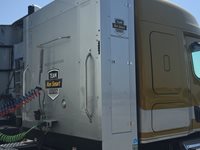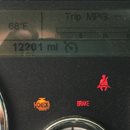 I was fortunate enough in my last CNG Cascadia to never have run my truck completely out of fuel. I was told when I first tried CNG about where I could safely run it down to, then ran it to a point slightly lower than that, which was at the very end of my comfort threshold. When incorporating a new CNG truck into my daily use, I have been fortunate
I was fortunate enough in my last CNG Cascadia to never have run my truck completely out of fuel. I was told when I first tried CNG about where I could safely run it down to, then ran it to a point slightly lower than that, which was at the very end of my comfort threshold. When incorporating a new CNG truck into my daily use, I have been fortunate  enough to use the previous experience in my CNG day cab as a base comparison for most everything. Using the old trucks "empty point" on fuel to determine this truck’s particular limits however, would teach me that the new truck is definitely it's own unique beast!
enough to use the previous experience in my CNG day cab as a base comparison for most everything. Using the old trucks "empty point" on fuel to determine this truck’s particular limits however, would teach me that the new truck is definitely it's own unique beast!
 My first mistake came in thinking that I could run the new truck down into the 300-400 psi range like my previous set of wheels. As I fired up for my morning run I saw that my gauge was sitting at 950 psi, out of its full capacity 3600 psi. With an early 50 mile jog down to Huntington Beach to deliver, then just having to deadhead back to my home base of Ontario for another quick morning pick up, I figured it would be no big deal to knock out this round trip and just fuel after it was all out of the way. By my estimate, this would have left me somewhere around 450-500 psi when it was time to refuel. Everything went according to plan, except for the fact that I ran out of fuel pulling out of the dock from the quick pickup in Ontario, just 2.5 miles from my regular fueling station.
My first mistake came in thinking that I could run the new truck down into the 300-400 psi range like my previous set of wheels. As I fired up for my morning run I saw that my gauge was sitting at 950 psi, out of its full capacity 3600 psi. With an early 50 mile jog down to Huntington Beach to deliver, then just having to deadhead back to my home base of Ontario for another quick morning pick up, I figured it would be no big deal to knock out this round trip and just fuel after it was all out of the way. By my estimate, this would have left me somewhere around 450-500 psi when it was time to refuel. Everything went according to plan, except for the fact that I ran out of fuel pulling out of the dock from the quick pickup in Ontario, just 2.5 miles from my regular fueling station.
 Just as there are no two snowflakes frozen to be identical as they fall to the ground, similarly I believe for certain that no two CNG fuel capacities are created equal! As I sat there calling a wrecker to come tow me to the fuel station because my low-pressure indicator was de-rating my engine to a 1-2 mph crawl, I began to kick myself in the rear for not fueling sooner, which would have avoided the whole issue. I do like that it has a de-rate feature though, which at least allowed me to unhook my tractor from the trailer and move the truck out of the way.
Just as there are no two snowflakes frozen to be identical as they fall to the ground, similarly I believe for certain that no two CNG fuel capacities are created equal! As I sat there calling a wrecker to come tow me to the fuel station because my low-pressure indicator was de-rating my engine to a 1-2 mph crawl, I began to kick myself in the rear for not fueling sooner, which would have avoided the whole issue. I do like that it has a de-rate feature though, which at least allowed me to unhook my tractor from the trailer and move the truck out of the way.
Something inside told me to try and key-on and key-off a few times as I sat there waiting and luckily I usually listen to my instinct. After a few times the truck fired up to regular idle and the de-rate function went off, even though the low-pressure warning stayed on. I called and cancelled the tow before he got there and scooted as quick as I could safely the couple of miles to the CNG station I frequent. I guess it all worked out in some weird way to educate me on the limits of my new CNG Cascadia. As the picture here shows, the new limit is now just above 122 DGE (Diesel Gallon Equivalent) of my 145 DGE capacity, which works out to 520 psi on the gauge. In the end I was able to avoid the cost of a tow, I  learned about the low-pressure safeguards, was still able to get the load there on-time! The most important thing I learned through all of this though, is that my old truck may serve as a good guide on how to handle situations in the new truck, but shouldn’t be relied on for exact critical comparisons such as this!
learned about the low-pressure safeguards, was still able to get the load there on-time! The most important thing I learned through all of this though, is that my old truck may serve as a good guide on how to handle situations in the new truck, but shouldn’t be relied on for exact critical comparisons such as this!